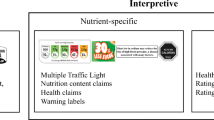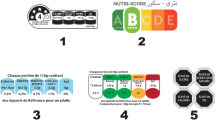Abstract
This research examines consumers’ processing of Facts-up-front food labels as implemented by the Grocery Manufacturers Association (GMA). Facts-up-front labels include both positive (virtues) and negative (vices) nutritional icons. The processing and relative efficacy of Facts-up-front labels are compared to the original FDA proposal of front-of-pack labels which only included vices. The results suggest heuristic processing of these labels, whereby consumers consider the nutritional icons on the front-of-pack labels similar to affective stimuli. The addition of virtues alongside vices on the label has a compensatory effect, i.e., the food item is evaluated as healthier when there are both virtues and vices on the label compared to when there are only vices. Such heuristic processing of Facts-up-front labels that allows nutritional virtues to compensate for nutritional vices has the potential for consumers evaluating harmful foods as relatively “healthy” thus compromising consumer well-being. These findings illustrate the importance of empirically testing changes to nutritional labels before large scale implementation. Since consumers process front-of-pack labels heuristically and not cognitively, it is not surprising that nutritional literacy does not moderate the effects of label design on healthiness evaluations. Furthermore, the order of the negative and positive information on Facts-up-front labels also has no effect.





Similar content being viewed by others
References
Baumeister, R. F., Bratslavsky, E., Finkenauer, C., & Vohs, K. D. (2001). Bad is stronger than good. Review of General Psychology, 5, 323–370.
Burton, S., Garretson, J. A., & Velliquette, A. M. (1999). Implications of accurate usage of nutrition facts panel information for food product evaluations and purchase intentions. Journal of the Academy of Marketing Science, 27, 470–480.
Chowdhury, R. M. M. I., Olsen, D. G., & Pracejus, J. W. (2008). Affective responses to images in print advertising: affect integration in a simultaneous presentation context. Journal of Advertising, 37, 7–18.
Diamond, J. (2004). Nutritional Literacy Scale. https://jdc.jefferson.edu/nls/1/
FDA (2018). Front-of-package labelling initiative. https://www.fda.gov/Food/LabelingNutrition/ucm202726.htm accessed Dec. 14, 2018.
Forgas, J. P. (2006). Affective influences on interpersonal behavior: towards understanding the role of affect in everyday interactions. In J. P. Forgas (Ed.), Affect in social thinking and behavior (pp. 269–290). New York: Psychology Press.
Fredrickson, B. L., & Kahneman, D. (1993). Duration neglect in retrospective evaluations of affective episodes. Journal of Personality and Social Psychology, 65, 45–55.
Hales, C. M., Fryar, C. D., Carroll, M. D., Freedman, D. S., & Ogden, C. L. (2018). Trends inobesity and sever obesity prevalence in US youth and adults by sex and age, 2007-2008 to 2015-2016. JAMA, 319, 1723–1725.
Haselton, M. G., & Ketelaar, T. (2006). Irrational emotions or emotional wisdom? The evolutionary psychology of affect and social behavior. In J. P. Forgas (Ed.), Affect in social thinking and behavior (pp. 21–39). New York: Psychology Press.
Hayes, A. F. (2013). Introduction to mediation, moderation, and conditional process analysis: a regression based approach. New York: Guilford.
Kees, J., Royne, M. B., & Cho, Y. (2014). Regulating front-of-package nutrition information disclosures: a test of industry self-regulation vs. other popular options. Journal of Consumer Affairs, 48, 147–174.
Labroo, A. A., & Ramanathan, S. (2006). The influence of experience and sequence of conflicting emotions on ad attitudes. Journal of Consumer Research, 33, 523–528.
Linville, P. W., & Fischer, G. W. (1991). Preferences for separating or combining events. Journal of Personality and Social Psychology, 60, 5–23.
Marchant, A. (2016). Industry orgs working to simplify nutrition and ingredient information for consumers. The Shelby Report, (December 22).
Newman, C. L., Burton, S., Andrews, J. C., Netemeyer, R. G., & Kees, J. (2018). Marketers use of alternative front-of-package nutrition symbols: an examination of effects on product evaluations. Journal of the Academy of Marketing Science, 46, 453–476.
Olsen, D. G., & Pracejus, J. W. (2004). Integration of positive and negative affective stimuli. Journal of Consumer Psychology, 14, 374–384.
Petty, R. E., & Cacioppo, J. T. (1986). The elaboration likelihood model of persuasion. Advances in Experimental Social Psychology, 19, 123–205.
Petty, R. E., De Steno, D., & Rucker, D. D. (2001). The role of affect in attitude change. In J. P. Forgas (Ed.), Handbook of Affect and Social Cognition Lawrence Erlbaum (pp. 212–233). NJ: Mahwah.
Schlosser, A. E. (2011). Can including pros and cons increase the helpfulness and persuasiveness of online reviews? The interactive affects of ratings and arguments. Journal of Consumer Psychology, 21, 226–239.
Yeung, C. W. M., & Wyer, R. S. (2004). Affect, appraisal and consumer judgment. Journal of Consumer Research, 31, 412–424.
Author information
Authors and Affiliations
Corresponding author
Additional information
Publisher’s note
Springer Nature remains neutral with regard to jurisdictional claims in published maps and institutional affiliations.
Rights and permissions
About this article
Cite this article
Zlatevska, N., Chowdhury, R.M.M.I., Tam, L. et al. Facts-up-front: should food companies follow the FDA or industry label format? The effects of combining virtue and vice information on consumer evaluations. Mark Lett 30, 321–334 (2019). https://doi.org/10.1007/s11002-019-09504-9
Published:
Issue Date:
DOI: https://doi.org/10.1007/s11002-019-09504-9




